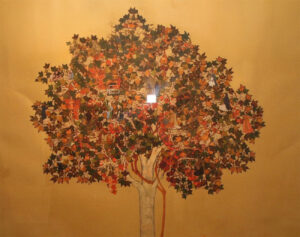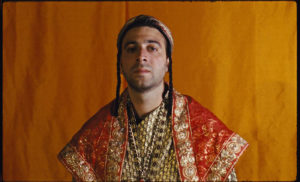
Praying to the West: How Muslims Shaped the Americas by Omar Mouallem
Simon & Schuster, 2021
ISBN 9781501199141
Francisco Letelier
Most understand that the story of the Americas has missing pieces. With Praying to the West, I learned more about the lives and influence of people often dismissed or relegated to the sidelines.
The author takes us on a decidedly dizzying journey that begins in Jerusalem and travels from his hometown of Edmonton, Canada then into Quebec and Ontario, and on to Chiapas, Mexico, Bahia, Brazil and Trinidad and Tobago. Spinning us through Michigan, North Dakota, Texas, the Northwest Territories and California, we are given a glimpse of the impact and reach of Muslims throughout the Americas.

Amidst the nationalities, languages, forms and branches of worship, it is easy to get lost in information. There is much attention given to details of Muslim life, and these often seem to lead away from how Muslims shaped the Americas. Throughout the author’s journey, however, I was reminded of how difficult this kind of journalism can be, demanding adaptation and diplomacy as he met with representatives and adherents wherever he went. The distances of language and culture are keenly felt when the author moves from North to South. In Latin America, faith makes its compromise with language and culture just as it does in North America. As a South American myself, I sensed the barriers the North American author confronted in his travels. It takes more than a Muslim background to pierce the skin of a new continent. The writer is often so focused on local Muslim communities that he fails to adequately include the geography, cultures and languages that surround Muslim communities.
It took character, courage and determination for the author’s ancestors to seek a new home in the Americas. Readers learn that 60% of the 95,000 people populating Dearborn, Michigan claim Middle Eastern ancestry. The Arab American Museum in Dearborn begins the story of Arab Americans with Mustafa Azemmouri, an enslaved explorer who left an imprint in Meso-America. The museum then skips centuries, arriving at the first wave of immigrants forming “little Syrias” in booming cities across North and South America. Three of the author’s grandfathers rode that wave, including one who worked at Henry Ford’s first auto plant with hundreds of other Lebanese (during the Ottoman era, Lebanon was part of what was known as Greater Syria, only forming its own identity in 1920).
Today in Dearborn, close to 30% of the population identifies as Muslim or affiliated. The vast majority are Shia, but in the United States and the world, the vast majority are Sunni.
Immigrants on the frontier of America, Muslim or otherwise, are vital to the story of the nation we call the United States. Middle Eastern workers joined Blacks, Jews, Irish and others in building not only cars but also the middle-class dream that today is still out of reach for so many. They really were shaping America. In the American psyche, arguably, even today there is nothing quite as “American” as a Ford.
But this book is inward-looking, giving tantalizing but cursory nods, rather than making grand claims concerning the shaping of broader swaths of American culture. In Chicago at a branch of the Nation of Islam, Mouallem writes:
Imam Agim Muhammed gave me goose bumps with his recitation of al-Fatiha. I’d heard it ten thousand times, but had never heard the Quran’s opening salvo sound like blues…Numerous scholars have argued a link between the American music and Islamic hymnody. I was skeptical until hearing Imam Agim bend, blend, and stretch each note as if covering Muddy Waters in a foreign language.
The blues continues to permeate and shape the Americas, but that is all we get from Mouallen on the life-changing power of this quintessential American music genre.
When he is closest to home, readers are teased, first with details about the Lebanese peddlers who once roamed the prairies of Canada and the Dakotas, and then examples of their modern equivalents. Although it may be true that the vast majority of Arabs on the American frontier were farmers, it’s also true that the traveling salesman, the trader and peddler are powerful icons that continue to shape the myths of nations.
In North Dakota, at the site of one of the oldest still existing mosques in the United States, one surrounded by wheat fields, we gain insight into the worship of Muslim pioneers. On the periphery of Ross, a town of 100 people 60 miles south of the Canadian border, Syrian and Lebanese immigrants held services with a coal stove, benches, and prayer rugs in a small 1929 sub-basement building:

“A small Chipewyan Lebanese group emerged in Turtle Mountain, North Dakota, but most, like Awid’s father, Ahmed, sought courtship from Eastern Europeans. (English and French women gave the men as little attention as the men gave Indigenous women.) However, as homesteaders arrived in droves, establishing pockets of Arabia amid wheat and mustard fields, mixed families became infrequent. By the 1920s, about three thousand Syrians lived in the Dakotas, of whom one-third were Muslim. They viewed the thousands of kilometers and borders between them almost as they would the next town over in Lebanon’s Bekaa Valley. The same Saskatchewan shaykh, an authorized faith leader, oversaw marriages and funerals in Alberta, Wyoming, and the Dakotas.”
Today, the Chipewa Nation recognizes those Syrian and Lebanese names and lineages. Yet the narrative of how Muslims shaped the Americas would have been better crafted had the author sought to also describe the experience of Native Americans with Muslims.
In a vast indigenous land populated by other communities, it seems important to trace where connections and common ground occur.
We are more than our prayers; we must dwell, also, in the places our prayers take us.
The Americas as a whole are a land in which we reconcile culture and memory with the spiritual beliefs and practices of ancestors. The diversity of Muslim belief, culture and prayer is overwhelming and perhaps the author offers more explanation than necessary about acceptance in America. Like many readers, I do not believe that I must justify myself or others in order to be perceived as a member of a “good community.” It is difficult to witness the writer engaged in doing so. Nonetheless, the racism and stereotyping of Muslims and Middle Eastern communities is a reality that cannot be ignored. Underlying the author’s narrative are lessons on how alliances with broader communities and faiths can provide insight and strength for Muslims.
Praying to the West contains beautiful passages as the author tests and explores his identity as a Muslim man, acknowledging the powerful threads woven into his daily life. While he slow to get there, it is uplifting to find the author discovering secular culture. Nevertheless, by the time the gates open to these ideas, the book is ending:
There was once a spirited tradition of Muslim elites publishing works that questioned dogma, prophethood, and only stopped short of trying to disprove God. Dedicated to values we might now call humanist — reason, empiricism, and free thought — these philosopher-scientists thrived during the medieval period known as the Islamic Golden Age. They’ve always existed, even if modern Muslim elites ignored or erased them by favoring conservative commentaries, a cover-up becoming harder to sustain in our Age of Information.
“So where does the Muslim start?” I asked Khaki.
Khaki said I was asking the wrong question. “It’s ‘Where does it end?’”
Having a Muslim background — based not in spirituality but history, politics, culture, family — was legitimate enough for Muslim identity. With this, I believed I had a place in the ummah.
The Americas are inhabited by other silent and buried histories; we walk next to one another, across geographies that our grandmothers made home. Our spiritual practices and beliefs live within the cultures we carry and it remains important to have global outlooks that can embrace our growing communities and nations. I was not disappointed when the book ended with a call to reach out towards places that need attention and human rights. If the book reveals a major weakness, it is that Mouallem spent perhaps too much time interviewing highly placed religious leaders in order to understand or give meaning to the Islamic experience in the Americas. It was as if he were disempowered to grant himself any spiritual agency — imagine if a Catholic wanted to explore the meaning of Catholicism, but set about talking mainly to priests, bishops, cardinals and the Pope, giving little importance to her/his fellow worshippers.
Nonetheless, the book’s bibliography is a gem and serves to point out areas of needed research. History is a living thing, a book that is constantly re-written. As research into Muslim culture in the Americas moves forward, new understandings will be revealed. This reader’s hope is that Praying to the West is only a beginning.

























